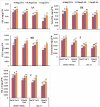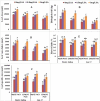Exogenous application of salicylic acid ameliorates salinity stress in barley (Hordeum vulgare L.)
- PMID: 38605311
- PMCID: PMC11008038
- DOI: 10.1186/s12870-024-04968-y
Exogenous application of salicylic acid ameliorates salinity stress in barley (Hordeum vulgare L.)
Abstract
Barley (Hordeum vulgare L.) is a significant cereal crop belonging to Poaceae that is essential for human food and animal feeding. The production of barley grains was around 142.37 million tons in 2017/2018. However, the growth of barley was influenced by salinity which was enhanced by applying a foliar spray of salicylic acid. The current study investigated to evaluated the potential effect of SA on the barley (Hordeum vulgare L.) plants under salinity stress and its possible effects on physiological, biochemical, and growth responses. The experiment was conducted at Postgraduate Research Station (PARS), University of Agriculture; Faisalabad to assess the influence of salicylic acid on barley (Hordeum vulgare L.) under highly saline conditions. The experiment was conducted in a Completely Randomized Design (CRD) with 3 replicates. In plastic pots containing 8 kg of properly cleaned sand, two different types of barley (Sultan and Jau-17) were planted. The plants were then watered with a half-strength solution of Hoagland's nutritional solution. After the establishment of seedlings, two salt treatments (0 mM and 120 mM NaCl) were applied in combining three levels of exogenously applied salicylic acid (SA) (0, 0.5, and 1 mg L-1). Data about morphological, physiological, and biochemical attributes was recorded using standard procedure after three weeks of treatment. The morpho-physiological fresh weight of the shoot and root (48%), the dry mass of the shoot and root (66%), the plant height (18%), the chlorophyll a (30%), the chlorophyll b (22%), and the carotenoids (22%), all showed significant decreases. Salinity also decreased yield parameters and the chl. ratio (both at 29% and 26% of the total chl. leaf area index). Compared to the control parameters, the following data was recorded under salt stress: spike length, number of spikes, number of spikelets, number of tillers, biological yield, and harvest index. Salicylic acid was used as a foliar spray to lessen the effects of salinity stress, and 1 mg L-1 of salicylic acid proved more effective than 0.5 mg L-1. Both varieties show better growth by applying salicylic acid (0 mg L-1) as a control, showing normal growth. By increasing its level to (0.5 mg L-1), it shows better growth but maximized growth occurred at a higher level (1 mg L-1). Barley sultan (Hordeum vulgare L.) is the best variety as compared to Jau-17 performs more growth to mitigate salt stress (0mM and 120mM NaCl) by improving morpho-physiological parameters by enhancing plan height, Root and shoot fresh and dry weights, as well as root and shoot lengths, photosynthetic pigments, area of the leaves and their index, and yield attributes and reduce sodium ions.
Keywords: Barley; Morphology; Physiology; Salicylic acid; Salinity; Yield.
© 2024. The Author(s).
Conflict of interest statement
The authors declare no competing interests.
Figures








Similar articles
-
Alleviating salinity stress in canola (Brassica napus L.) through exogenous application of salicylic acid.BMC Plant Biol. 2024 Jun 27;24(1):611. doi: 10.1186/s12870-024-05314-y. BMC Plant Biol. 2024. PMID: 38926637 Free PMC article.
-
Timing-dependent effects of salicylic acid treatment on phytohormonal changes, ROS regulation, and antioxidant defense in salinized barley (Hordeum vulgare L.).Sci Rep. 2020 Aug 17;10(1):13886. doi: 10.1038/s41598-020-70807-3. Sci Rep. 2020. PMID: 32807910 Free PMC article.
-
Foliar fertigation of ascorbic acid and zinc improves growth, antioxidant enzyme activity and harvest index in barley (Hordeum vulgare L.) grown under salt stress.Plant Physiol Biochem. 2021 Jan;158:244-254. doi: 10.1016/j.plaphy.2020.11.007. Epub 2020 Nov 7. Plant Physiol Biochem. 2021. PMID: 33221118
-
Advances in Identifying the Mechanisms by Which Microorganisms Improve Barley Salt Tolerance.Life (Basel). 2023 Dec 19;14(1):6. doi: 10.3390/life14010006. Life (Basel). 2023. PMID: 38276255 Free PMC article. Review.
-
Unraveling the Hidden Potential of Barley (Hordeum vulgare): An Important Review.Plants (Basel). 2024 Aug 30;13(17):2421. doi: 10.3390/plants13172421. Plants (Basel). 2024. PMID: 39273905 Free PMC article. Review.
Cited by
-
Modulation of Photosystem II Function in Celery via Foliar-Applied Salicylic Acid during Gradual Water Deficit Stress.Int J Mol Sci. 2024 Jun 18;25(12):6721. doi: 10.3390/ijms25126721. Int J Mol Sci. 2024. PMID: 38928427 Free PMC article.
-
The rational design of a Rhodamine fluorescent probe enables the selective detection and bioimaging of salicylic acid in plants under abiotic stress.Plant Biotechnol J. 2025 May;23(5):1736-1750. doi: 10.1111/pbi.70003. Epub 2025 Feb 13. Plant Biotechnol J. 2025. PMID: 39945300 Free PMC article.
-
Response of Purslane Plants Grown under Salinity Stress and Biostimulant Formulations.Plants (Basel). 2024 Aug 30;13(17):2431. doi: 10.3390/plants13172431. Plants (Basel). 2024. PMID: 39273915 Free PMC article.
-
Optimization of ultrasonic-assisted extraction of soluble dietary fiber (β-glucan) from different barley varieties and study of its characterization and functional attributes.Food Sci Nutr. 2024 Sep 4;12(10):8394-8407. doi: 10.1002/fsn3.4421. eCollection 2024 Oct. Food Sci Nutr. 2024. PMID: 39479682 Free PMC article.
References
-
- El-Hashash EF. KM El-Absy 2019 Barley (Hordeum vulgare L.) breeding. Adv Plant Breed Strategies: Cereals 5 1–45.
-
- Shavanov M. The role of food crops within the Poaceae and Fabaceae families as nutritional plants. In: IOP Conference Series: Earth and Environmental Science: 2021. IOP Publishing: 012111.
-
- Memon TA. Assessment of Rice residues as potential energy source in Pakistan. Sukkur IBA J Emerg Technol. 2022;5(1):41–53. doi: 10.30537/sjet.v5i1.982. - DOI
-
- Al-Bawwat AK, Jurado F, Gomaa MR, Cano A. Availability and the possibility of employing wastes and biomass materials energy in Jordan. Sustainability. 2023;15(7):5879. doi: 10.3390/su15075879. - DOI
-
- Jat ML, Chakraborty D, Ladha JK, Parihar CM, Datta A, Mandal B, Nayak HS, Maity P, Rana DS, Chaudhari SK. Carbon sequestration potential, challenges, and strategies towards climate action in smallholder agricultural systems of South Asia. Crop Environ. 2022;1(1):86–101. doi: 10.1016/j.crope.2022.03.005. - DOI
MeSH terms
Substances
LinkOut - more resources
Full Text Sources
Miscellaneous

